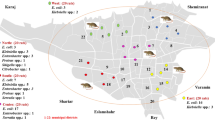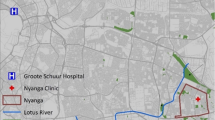Abstract
Pathogenic Escherichia coli (PEc) is a leading cause of both foodborne and waterborne illness. In September 2012, a major foodborne outbreak with PEc occurred, affecting approximately 1,200 students and food handlers from 7 schools in Gyeonggi province, South Korea caused by contaminated kimchi. For detection of PEc in kimchi, real-time polymerase chain reaction (RT-PCR) and traditional culture methods were used. EAEC and ETEC genotypes were identified in samples from individuals with the illness and in kimchi using conventional PCR. Bacteria in stool samples were genetically similar to bacteria from kimchi (98% homology). PEc from kimchi was identified as the causative agent of a foodborne outbreak in South Korea. A significant link between kimchi and individuals with foodborne illnesses after consuming kimchi was demonstrated.
Similar content being viewed by others
References
Huerta M, Grotto I, Gdalevich M, Mimouni D, Gavrieli B, Yavzori M, Cohen D, Shpilberg O. A waterborn outbreak of gastrointeritis in the golan heights due to enterotoxigenic Escherichia coli. Infection 28: 267–271 (2000)
Choi SK, Lee MH, Lee BH, Jung JY, Choi C. Virulence factor profiles of Escherichia coli isolated from pork and chicken meats obtained from retail markets. Korean J. Food. Sci. Ani. Resour. 30: 148–153 (2010)
Qadri F, Svennerholm AM, Faruque ASG, Bradley Sack R. Enterotoxigenic Escherichia coli in developing countries: Epidemiology, microbiology, clinical features, treatment, and prevention. Clin. Micrbiol. Rev. 18: 465–483 (2005)
Tamaki Y, Narimatsu H, Miyazato T, Nakasone N, Higa N, Toma C, Iwanaga M. The relationship between o-antigens and pathogenic genes of diarrhea-associated Escherichia coli. Jpn. J. Infec. Dis. 58: 65–69 (2005)
Chattaway MA, Dallman T, Okeke IN, Wain J. Enteroaggregative E. coli O104 from an outbreak of HUS in Germany 2011, could it happen again? J. Infect. Dev. Ctries. 5: 425–436 (2011)
Karmali MA, Gannon V, Sargeant JM. Verocytotoxin-productin Escherichia coli (VTEC). Vet. Microbial. 140: 360–370 (2010)
David AR, Rosovitz MJ, Myers GSA, Mongodin EF, Florian Fricke W, Pawel G, Jonathan C, Mohammed S, Nicholas RT, Roy C, Ian RH, Vanessa S, Jacques R. The pangenome structure of Escherichia coli: Comparative genomic analysis of E. coli commensal and pathogenic isolates. J. Bacteriol. 190: 6881–6893 (2008)
Nataro JP, Kaper JB. Diarrheagenic Escherichia coli. Clin. Microbiol. Rev. 11: 142–201 (1998)
Deng K, Wang S, Rui X, Zhang W, Tortorello ML. Functional analysis of ycfR and ycfQ in Escherichia coli O157:H7 linked to outbreaks of illness associated with fresh produce. Appl. Environ. Microb. 3952–2959 (2011)
Buchholz U, Bernard H, Werber D, Bohmer M, Remschmidt C, Wilking H, Delere Y, der Heiden M, Adlhoch C, Dreesman J, Ehleres J, Ethelberg S, Faber M, Frank C, Fricke G, Greiner M, Hohle M, Ivarsson S, Jark U, Kirchner M, Koch J, Krause G, Luber P, Rosner B, Stark K, Kuhne M. German outbreak of Escherichia coli O104:H4 associated with sprouts. New Engl. J. Med. 365: 1763–1770 (2011)
Kim MJ, Kim SH, Kim TS, Kee HY, Seo JY, Kim ES, Park JT, Chung JK, Lee J. Identification of Shiga Toxin-producing E. coli isolated from diarrhea patients and cattle in Gwangju area, Korea. J. Bacteriol. Virol. 39: 29–39 (2009)
Fluit AC, Terlingen AM, Andriessen L, Ikawaty R, van Mansfeld R, Top J, Cohen Stuart JW, Hall AL, Boel CHE. Evaluation of the diversilab system for detection of hospital outbreaks of infections by different bacterial species. J. Clin. Microbiol. 48: 3979–3989.
Healy B, Mullane N, Collin V, Mailler S, Iversen C, Chatellier S, Storrs M, Fanning S. Evaluation of an automated repetitive sequence-based PCR system for subtyping Enterobacter sakazakii. J. Food. Protect. 71: 1372–1378 (2008)
Bianca T, Sara TH, Susanne J, Hans F, Per O, Paual M. Evaluation of molecula typing methods for identification of outbreak-associated Neisseria meningitides isolates. Acta Pathol. Microbiol. Immunol. Scand. 121: 503–510 (2012)
Ariane D, Olivier D, Hector RV, Raf DR, Marc JS, Marie H. Controlled performance evaluation of the DiversiLab repetitivesequence-based genotyping system for typing multidrug-resistant health care-associated bacterial pathogens. J. Clin. Microbiol. 49: 3616–3620 (2011)
Abay S, Aydin F, Sumerkan AB. Molecular typing of Listeria spp. isolated from different sources. Ankara Univ. Vet. Derg. 59: 183–190 (2012)
Ministry of Food and Drug Safety. E.coli O157:H7 detection method in Korean Food Standards Codex. Available from: http://fse.foodnara.go.kr/residue/RS/jsp/menu. Accessed Aug. 05, 2013.
Brandal LT, Lindstedt BA, Aas L, Stavnes TL, Lassen J, Kapperud G. Octaplex PCR and fluorescence-based capillary electrophoresis for identigication of human diarrheagenic Escherichia coli and Shigella spp. J. Microbiol. Meth. 68: 331–341 (2007)
Bonacorsi S, Bidet P, Mahjoub F, Mariami-Kurkdjian P, Ait-Ifrane S, Courroux C, Bingen E. Semi-automated rep-PCR for rapid differentiation of major clonal groups of Escherichia coli meningitis strains. Int. J. Med. Microbiol. 299: 402–409 (2009)
Kagkli DM, Folloni S, Barbau-Piednoir E, Van den Eede G, Van den Bulcke M. Towards a pathogenic Escherichia coli detection platform using multiplex SYBR Green real-time PCR methods and high resolution melting analysis. PLoS ONE 7: e39287 (2012)
Yang JR, Wu FT, Tsai JL, Mu JJ, Lin LF, Chen KL, Kuo SHS, Chiang CS, Wu HS. Comparison between O serotyping method and multiplex real-time PCR to identify diarrheagenic Escherichia coli in Taiwan. J. Clin. Microbiol. 45: 3620 (2007)
Konishi N, Obata H, Monma C, Nakama A, Kai A, Tsuji T. Bacteriological and epidemiological characteristics of Enterotoxigenic Escherichia coli isolated in Tokyo, Japan, between 1966 and 2009. J. Clin. Microbiol. 49: 3348 (2011)
Rodas C, Mamani R, Blanco J, Blanco JE, Wiklund G, Svennerholm AM, Sjoling A, Iniguez V. Enterotoxins, colonization factors, serotypes, and antimicrobial resistance of enterotoxigenic Escherichia coli (ETEC) strains isolated from hospitalized children with diarrhea in Bolivia. Braz. J. Infect. Dis. 15: 132–137 (2011)
Pablo CO, Herbert LD. Enteroaggregative Escherichia coli (EAEC): A cause of acute and persistent diarrhea of worldwide importance. J. Infect. Dis. 202: 503–505 (2010)
Kimata K, Shima T, Shimizu M, Tanaka D, Lsobe J, Gyobu Y, Watahiki M, Nagai Y. Rapid categorization of pathogenic Escherichia coli by multiplex PCR. Microbiol. Immunol. 49: 485–492 (2005)
Rajkhowa S, Hussain I, Rajkhowa C. Detection of heat-stable and heat-labile enterotoxin genes of Escherichia coli in diarrhoeic faecal samples of mithun (Bos frontails) calves by polymerase chain reaction. J. Appl. Microbiol. 106: 455–458 (2009)
Ansaruzzaman M, Bhuiyan NA, Begum YA, Kuhn I, Nair GB, Sack DA, Svennerholm A-M, Qadri FJ. Characterization of enterotoxigenic Escherichia coli from diarrhoeal patients in Bangladesh using phenotyping and genetic profiling. Med. Microbiol. 56: 217–222 (2007)
Rao MC. Toxins which activate guanylate cyclase: Heat-stable enterotoxins. Ciba. Found. Symp. 112: 74–93 (1985)
Sears CL, Kaper JB. Enteric bacterial toxin: Mechanisms of action and linkage to intestinal secretion. Microbiol. Rev. 60: 167–215 (1996)
Fluit AC, Terlingen AM, Andriessen L, Ikawaty R, van Mansfeld R, Top J, Cohen Syuart JW, Leverstein-van Hall MA, Boel CHE. Evaluation of DiversiLab system for detection of hospital outbreaks of infections by different bacterial species. J. Clin. Microbiol. 48:3979 (2010)
Author information
Authors and Affiliations
Corresponding author
Rights and permissions
About this article
Cite this article
Cho, JI., Joo, IS., Park, KS. et al. Characterization of pathogenic Escherichia coli strains linked to an outbreak associated with kimchi consumption in South Korea, 2012. Food Sci Biotechnol 23, 209–214 (2014). https://doi.org/10.1007/s10068-014-0028-1
Received:
Revised:
Accepted:
Published:
Issue Date:
DOI: https://doi.org/10.1007/s10068-014-0028-1




